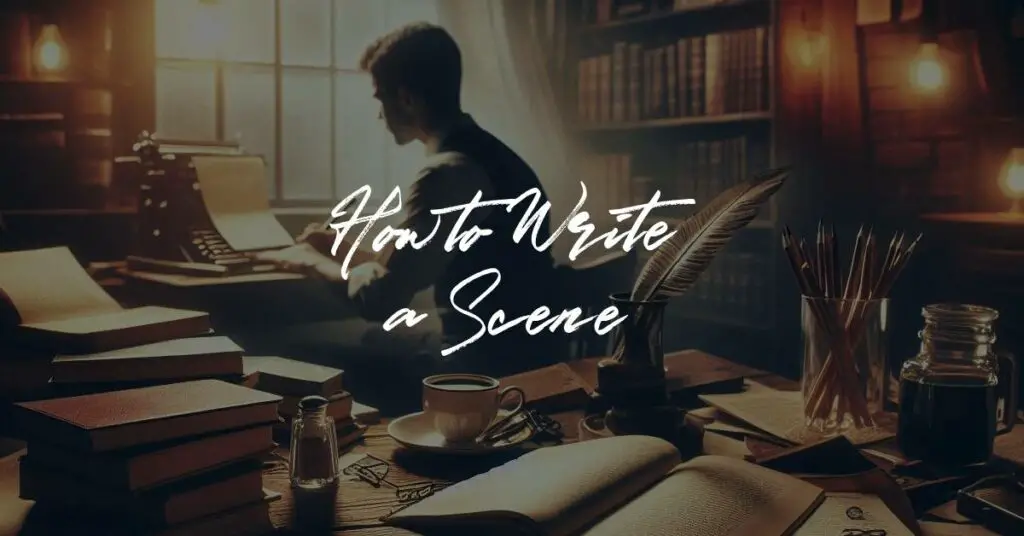Writing compelling scenes is an art that lies at the heart of successful storytelling. Whether you’re crafting a novel, short story, or screenplay, understanding how to write effective scenes can make the difference between a page-turner and a story that falls flat.
In this comprehensive guide, we’ll explore everything you need to know about scene writing, from fundamental concepts to advanced techniques that will elevate your storytelling.
What Defines a Scene in Writing?
A scene is more than just a segment of your story—it’s a vital building block that moves your narrative forward through action, dialogue, and character development.
Each scene serves as a miniature story within your larger narrative, complete with its own beginning, middle, and end. Think of scenes as the individual brushstrokes that come together to create a masterpiece.

Great scenes share several key characteristics:
- They advance the plot meaningfully
- They reveal character through action and dialogue
- They create emotional resonance with readers
- They maintain narrative momentum
- They contribute to the overall story arc
Scene Fundamentals
Understanding Scene Purpose
Every scene must earn its place in your story. Before writing, ask yourself: “What vital function does this scene serve?” Scenes typically fulfill one or more of these purposes:
- Advancing the main plot
- Developing character relationships
- Revealing crucial information
- Building tension or conflict
- Setting up future events
- Providing necessary context or background
The distinction between scenes and sequels is crucial for pacing. While scenes focus on action and conflict, sequels allow characters (and readers) to process events, make decisions, and prepare for what comes next.
Core Elements of Every Scene
Setting and Atmosphere
Your scene’s setting should do more than just establish location—it should enhance the mood and support the scene’s emotional impact. Consider how environmental details can reflect or contrast with the scene’s tone:
- Use sensory details to make the setting vivid
- Choose weather and time of day deliberately
- Include environmental elements that can influence the action
- Create atmosphere through selective detail
Character Presence and Point of View
Who’s present in your scene, and through whose eyes do we experience it? These choices significantly impact how readers engage with the events:
- Select the most effective viewpoint character
- Maintain consistent perspective
- Show other characters through the viewpoint character’s perceptions
- Use physical reactions to convey emotions
Conflict and Stakes
Every compelling scene needs conflict, whether internal or external:
- Establish clear opposition to the character’s goals
- Raise the stakes progressively
- Create multiple layers of conflict when possible
- Ensure the conflict matters to both character and plot
Scene Structure
The Three-Act Scene Structure
Just like your overall story, individual scenes benefit from a clear structure:
Opening (Hook and Setup)
- Begin with a strong hook
- Establish the scene’s context quickly
- Orient readers in time and space
- Introduce the scene’s central conflict
Middle (Development and Complications)
- Escalate tension progressively
- Introduce complications
- Deepen character relationships
- Build toward the scene’s climax
Ending (Payoff and Transition)
- Deliver a satisfying resolution or twist
- Create momentum for the next scene
- Leave readers wanting more
- Plant seeds for future developments
Scene Components Deep Dive
Scene Goal
Every scene should have a clear objective:
- What does the viewpoint character want?
- What obstacles stand in their way?
- How does this goal connect to the larger story?
- What’s at stake if they fail?
Scene Conflict
Conflict drives your scene forward:
- Create meaningful opposition
- Layer external and internal conflicts
- Ensure conflicts feel organic
- Make the resolution uncertain
Step-by-Step Scene Writing Process
Pre-Writing Phase
Before diving into writing, prepare thoroughly:
- Identify the scene’s primary purpose
- Choose the most effective point of view
- Set clear objectives for the scene
- Create a basic scene outline
- Understand how the scene fits into the larger narrative
Writing Phase
Crafting a Strong Opening
Your scene’s opening must accomplish several things:
- Hook readers immediately
- Establish the viewpoint character
- Set the tone and mood
- Orient readers in time and space
- Begin building tension
Developing the Middle
The middle portion of your scene should:
- Escalate conflict naturally
- Maintain reader interest
- Reveal character through action and dialogue
- Keep the pacing appropriate to the scene type
Creating a Powerful Ending
End your scene with impact:
- Deliver a satisfying payoff
- Create anticipation for what’s next
- Tie up immediate threads while leaving larger questions open
- Transition smoothly to the next scene
Post-Writing Phase
After completing your draft, evaluate your scene:
- Does it accomplish its purpose?
- Is the conflict compelling?
- Does it advance the story?
- Is the pacing appropriate?
- Are the characters’ actions consistent?
Part 4: Advanced Scene Writing Techniques
Creating Dynamic Scenes
Take your scenes to the next level with these advanced techniques:
Building and Releasing Tension
- Create multiple layers of tension
- Vary the intensity
- Use pacing to control emotional impact
- Build to meaningful climaxes
Using Subtext Effectively
- Layer meaning beneath the surface
- Show unspoken feelings through action
- Create dramatic irony
- Use symbolism purposefully
Managing Multiple Characters
- Keep track of everyone’s motivations
- Balance dialogue and action
- Maintain clear character distinctions
- Use group dynamics to create tension
Specialized Scene Types
Different scenes require different approaches:
Action Scenes
- Use short, punchy sentences
- Focus on immediate sensory details
- Maintain clear spatial relationships
- Keep the pace quick but comprehensible
Emotional Scenes
- Balance internal and external reactions
- Use physical responses to show feelings
- Avoid melodrama
- Ground emotions in character history
Dialogue-Heavy Scenes
- Give each character a distinct voice
- Use dialogue to reveal character
- Include meaningful subtext
- Balance dialogue with action beats
Common Scene Writing Problems and Solutions
Typical Mistakes to Avoid
Watch out for these common pitfalls:
- Starting scenes too early or too late
- Including unnecessary exposition
- Writing “on-the-nose” dialogue
- Lacking clear conflict or purpose
- Overwriting descriptions
- Losing focus on the scene’s goal
Solutions and Fixes
When revising, consider these strategies:
- Cut the first paragraph and see if the scene improves
- Ensure every line serves a purpose
- Remove unnecessary character movements
- Strengthen the central conflict
- Tighten pacing by removing filler
- Add sensory details where needed
Part 6: Scene Writing Tools and Exercises
Practice Techniques
Improve your scene writing through deliberate practice:
- Write the same scene from different viewpoints
- Practice starting scenes in media res
- Experiment with different pacing approaches
- Analyze scenes from your favorite books

Resources for Improvement
Continue developing your skills through:
- Writing workshops and critique groups
- Scene analysis exercises
- Regular practice and experimentation
- Studying successful scenes in published works
Conclusion
Mastering scene writing is a journey that requires practice, patience, and persistence. Remember these key points:
- Every scene needs a clear purpose
- Conflict drives scenes forward
- Structure supports emotional impact
- Characters must want something
- Details should serve the scene’s purpose
Keep practicing and refining your technique. With time and dedication, you’ll develop an intuitive sense for crafting scenes that captivate readers and serve your story effectively.
Scene Writing Checklist
Before finalizing any scene, ensure it:
- Has a clear purpose and goal
- Contains meaningful conflict
- Advances the story
- Reveals character
- Maintains appropriate pacing
- Transitions effectively
- Creates emotional impact
- Serves the overall narrative
Remember, great scenes don’t just happen—they’re crafted with intention, refined through revision, and polished until they shine. Keep this guide handy as you write, and return to it whenever you need to troubleshoot or strengthen your scenes.
